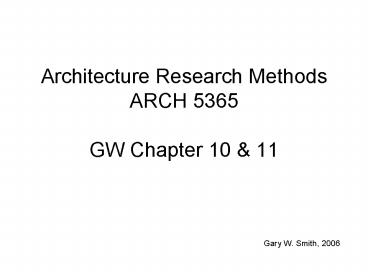Architecture Research Methods ARCH 5365 GW Chapter 10 - PowerPoint PPT Presentation
1 / 20
Title:
Architecture Research Methods ARCH 5365 GW Chapter 10
Description:
Simulation Research can circumvent ethical impossibilities because the ... is making sense of some aspect of the cosmos in a systematically rational manner ... – PowerPoint PPT presentation
Number of Views:73
Avg rating:3.0/5.0
Title: Architecture Research Methods ARCH 5365 GW Chapter 10
1
Architecture Research MethodsARCH 5365GW
Chapter 10 11
- Gary W. Smith, 2006
2
Simulation and Modeling Research
- Simulation Research can circumvent ethical
impossibilities because the replicated context is
one that gets at issues of human interaction and
behavior without placing the actors into
compromising positions
3
- Simulation involves controlled replications of
real-world contexts or events for the purposes of
studying dynamic interactions within that setting
(virtual worlds)
4
- Simulation is useful
- when dealing with questions of scale and
complexity - for studying the subjective dimensions of human
behavior - in materials testing (often)
- in developing theory and in testing theory
5
- Four types of simulation models
- Iconictesting of materials
- Analogdynamic simulation of an actual or
proposed physical system - Operationalpeoples interaction within physical
contexts - Mathematicalnumerical quantification of
real-world relationships
6
- Tactical Concerns
- Accuracy of Replication
- Completeness of Input Data
- Programmed spontaneityhow far from reality
- Cost and workability
7
Strengths
- Able to reveal results that can help with
additional research or actions - Provides a variety of ways of understanding the
future behavior of a context - Can be a primary tactic of experimental research
- Tend to be tactically useful in other strategies
8
Weaknesses
- Cannot assure the completeness of the replication
- Can be very expensive
9
Logical Argumentation
- Logical Argumentation is making sense of some
aspect of the cosmos in a systematically rational
manner
10
- Primary logical systems are logical systems that
have broad explanatory power. These can be the
basis or start of secondary studies which can go
deeper into the realm discussed in the primary
system.
11
- Three main venues of logical argumentation
- 1. mathematical/formal mathematical
constructions and computer models - 2. mathematical/cultural formal models that are
connected to social-cultural interpretations - 3. cultural/discursive design treatises or
justifications for architectural action by appeal
to larger transcendental contexts
12
- TRAITS of Logical Argumentation
- Broad systemic applicability
- Lay claim to universal explanatory power
- Mathematical determinism
- Rhetorical/polemical convictions that find
acceptance in a large audience - Paradigmatic Innovation
- Primary logical systems tend to be innovative
ones a new way of looking at old facts or
existing phenomena - Most draw from previous ideas
13
- (TRAITS of Logical Argumentation Cont.)
- A Priori Argumentation
- Reliant upon a priori principles
- A priori if it can be identified, then necessary
consequences ensue from it. (A priori means
previous to experience) - Testability
- The outcome of a mathematical-formal logical
system is often a set of quantitative tools that
can be used to diagnose empirical conditions. - The outcome of a cultural discursive logical
system is normative standards - They make sense to a wide cultural audience it
is logical within that cultural milieu
14
First Principles of Quantity To construct a
conceptual system that can explain the widest
scope of the phenomenon with the least number of
fundamental principles First Principles of
Quality An implicit argument for quality that
comes with essential elements of quantity once
the quantity has been determined, the quality is
necessarily determined as well.
15
- First Principles of Origin
- Genetic Origin something can be explained
because of its origins - Enabling Origin the quality came from the
necessary quantities
16
- Relationships between terms
- Necessity if a b and a c, then a d
- Deduction/induction
- deduction involves necessary connections
- induction draws generalizations from given facts
beyond what is inherent in only those facts. It
involve contingency (not as strong as necessary). - Syllogistic Frameworks
- Primary and secondary premises leading to a
necessary conclusion if x y and y z, then x
z
17
- Relationships between terms
- A priori/A Posteriori a priori is previous to
experience and comes out of necessity form
follows function. A posteriori refers to truths
that are established as a result of experience. - Entailment/implication
- Within a system, entailment can mean what any one
component of that system necessarily implies for
other components within the same system.
18
- Rhetorical Tactics in Cultural/Discursive Systems
- Naming identifying the various elements which
are the object of discourse - Association or Disassociation
- Association connection to a larger
transcendental realm - Disassociation Disagreeing with the established
norm dissent. - Story a tale that explains reasoning
19
- (Rhetorical Tactics in Cultural/Discursive
Systems Cont.) - Graphic images
- Implicit or explicit appeals to group identity
- Dividing providing options for discussion i.e.
handmade versus machine made - Authority authority is based on the coherence of
its argumentation and its explanatory power, but
also gains authority if it is spoken by an
established voice, if connected to a larger body
of voices saying related things, or can harness
the energy of an emerging trend.
20
- Review/Reread Strengths and Weaknesses































